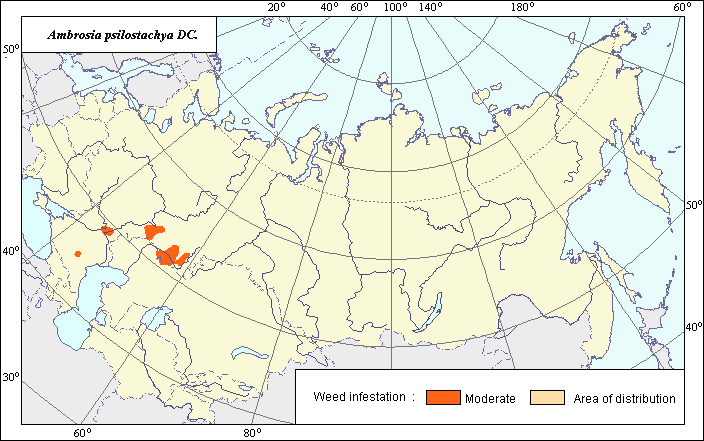Weeds
Area of distribution and weediness of Perennial Ragweed (Ambrosia psylostachya DC.)
 Object description Download GIS-layers
Object description Download GIS-layers
Authors:
Specialist-biologist - O.E.Kravchenko,GIS-specialist - I.A.Budrevskaya.
Date of creation:
15.09.2004.Scale:
1:20 000 000.Accuracy of the map:
It is created on material of map of natural scale 1:55 000 000 and on literature data.Projection:
"Alber's Equal Area Conic for the USSR", 9, 1001, 7, 100, 0, 44, 68, 0, 0.Basic content:
Vector map. Area (main distribution) and zone of weediness are shown by polygons.Accuracy of the classifier:
Area of distribution of the species is divided into zones of main distribution and weediness. Perennial Ragweed is is a quarantine object, so after G.P. Moskalenko (2001) we consider it as harmful object within zone of main distribution in limits of agricultural lands.Procedure of map drawing:
Zones of distribution and weediness are allocated by results of the analysis of the open-published cartographical materials and literature. Perennial Ragweed is a new invasive weed originating in Northern America. In the USSR the Perennial Ragweed has been found for the first time by the State Inspection on Plant Quarantine in 1945 in Krasnodar Territory. Other places of primary invasions of the weed have been found later. Now the Perennial Ragweed is included in "List of Quarantine Plants" as seldom meeting plant in Russia, Ukraine, and Kazakhstan. Quantity, distribution, and size of its centers are very changeable. The Inspection has liquidated some centers, for example in Krasnodar Territory; however, appearance of new centers is possible. Our map is constructed on data of Moskalenko (2001). It is the unique published material about distribution of the Perennial Ragweed in the limits of the former USSR.Sources of the data:
Bassett, I. J. & Crompton, C. W. 1975. The biology of Canadian weeds. 11. Ambrosia artemisiifolia L. and A. psylostachya DC. Can. J. Plant Sci. 55: 463-476.Cherepanov, S.K. 1995. Vascular plants of Russia and adjacent states (of the former USSR). Saint-Petersburg: Mir i semya-95. 991 pp. (in Russian).
Government of Republic Kazakhstan, 2002. The decision from December, 10, 2002, N 1295. .About the statement of lists of the objects of quarantine and of the especially dangerous harmful organisms. Quarantine objects which seldom meet in territory of Republic Kazakhstan. / http://ru.government.kz/documents/premlaw/12.2002/page05 (in Russian).
Government of the Russian Federation, 2003. The decision from March, 31, 2003. .List of pests, agents of diseases, and weeds, which have the quarantine status for the Russian Federation. (Quarantine objects, which seldom meet in territory of the Russian Federation)
Ministry of Agriculture and Food Production of Ukraine, 1992. The decision from June, 19, 1992. .Extraction from the list of pests, diseases of plants and weeds, which have the quarantine status in Ukraine. (The quarantine organisms, which seldom met in territory of Ukraine) / http://www.pole-port.dp.ua/doc/gosty/se3.htm ,
http://uga-port.org.ua/cgi-bin/valmenu_portal.sh?0p18021206.html (in Russian).
Moskalenko, G.P. & Yudin, B.I. 1999. Atlas of seeds and fruits of the weed plants meeting in quarantine cargoes and materials. Moscow: TNI KMK. 264 pp. (in Russian).
Moskalenko, G.P. 2001. Quarantine weeds of Russia. Moscow: Rosgoskarantin, 280 pp. (in Russian).
Nikitin, V.V. 1983. Weed plants of the USSR flora. Leningrad: Nauka. 454 pp. (in Russian).

